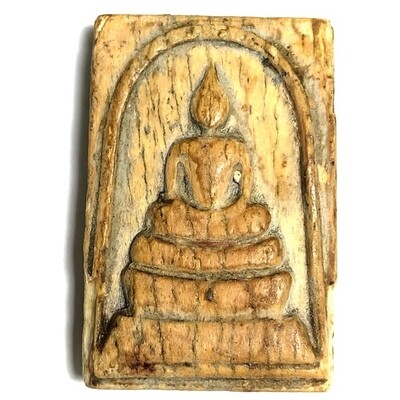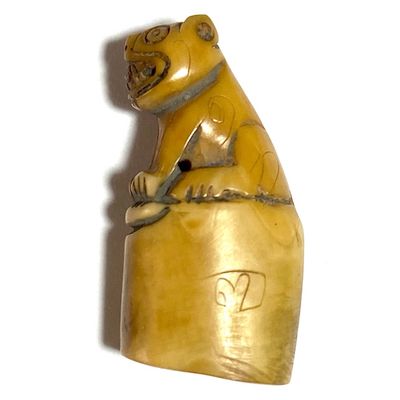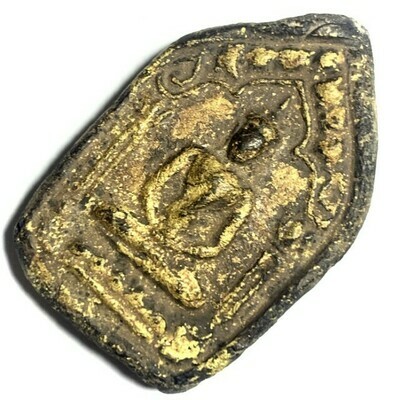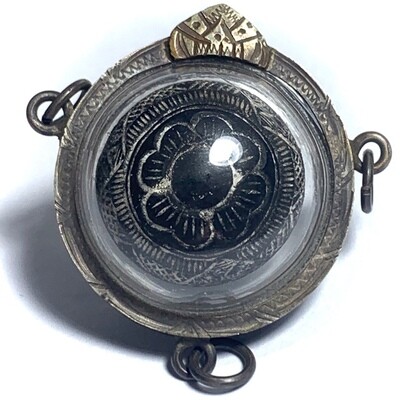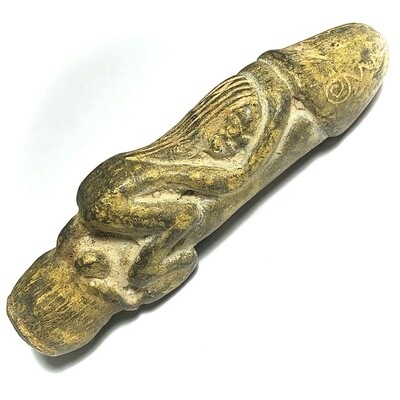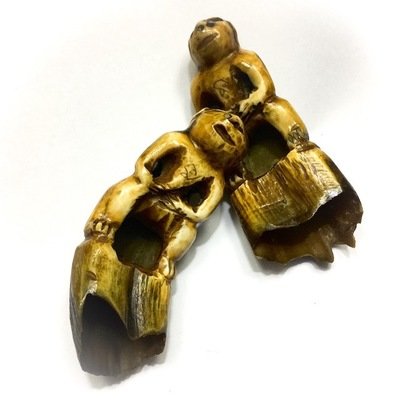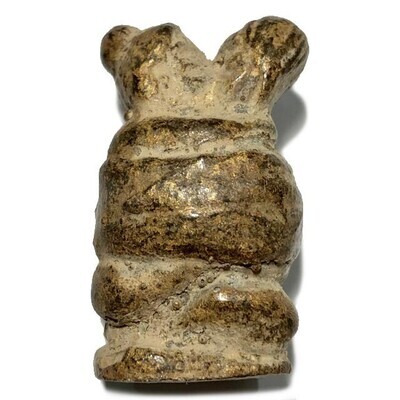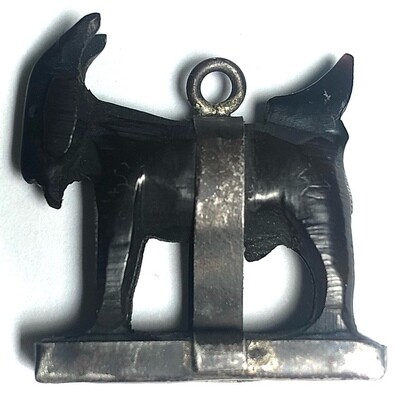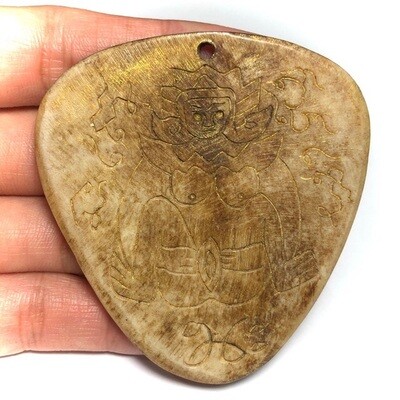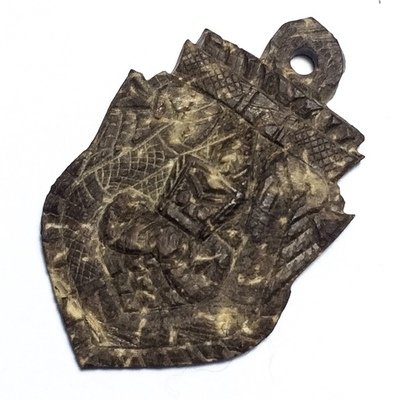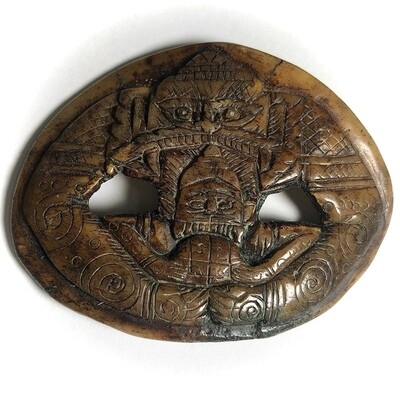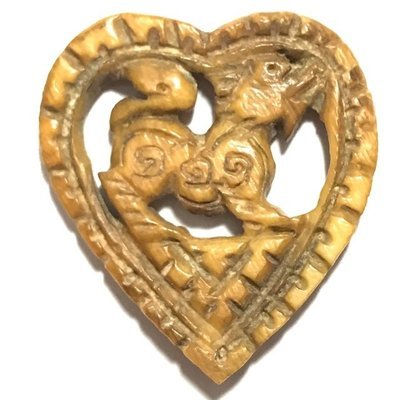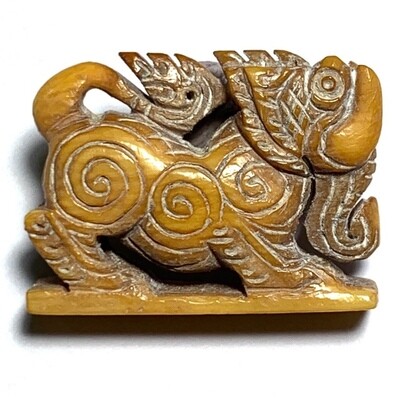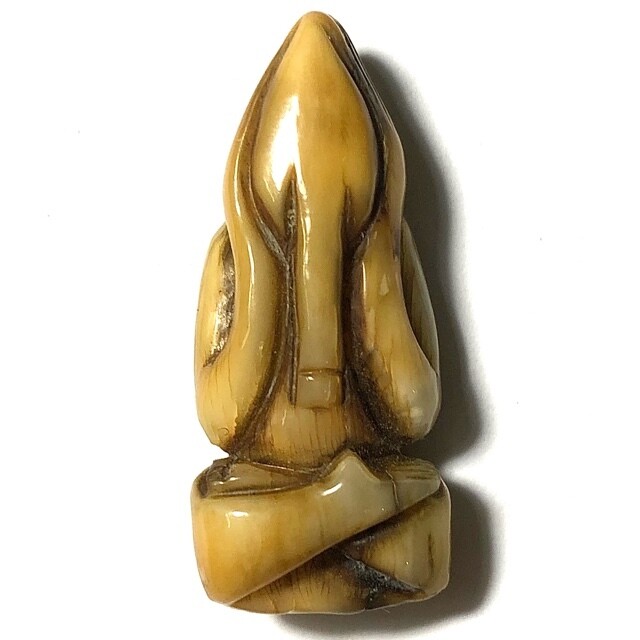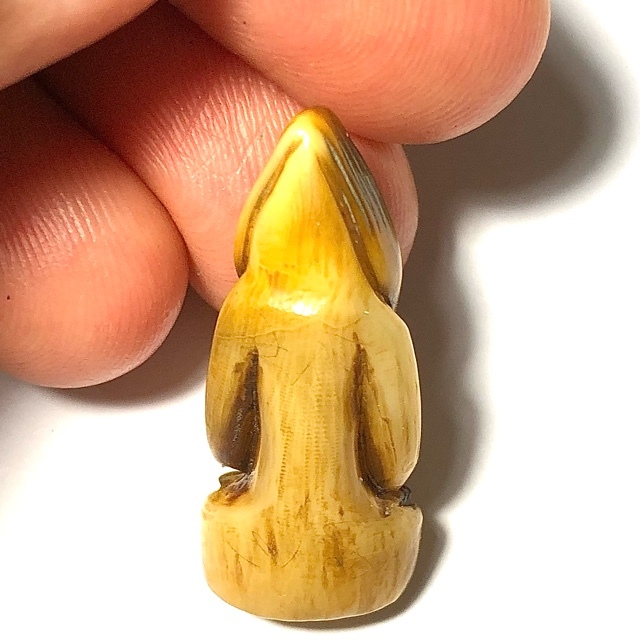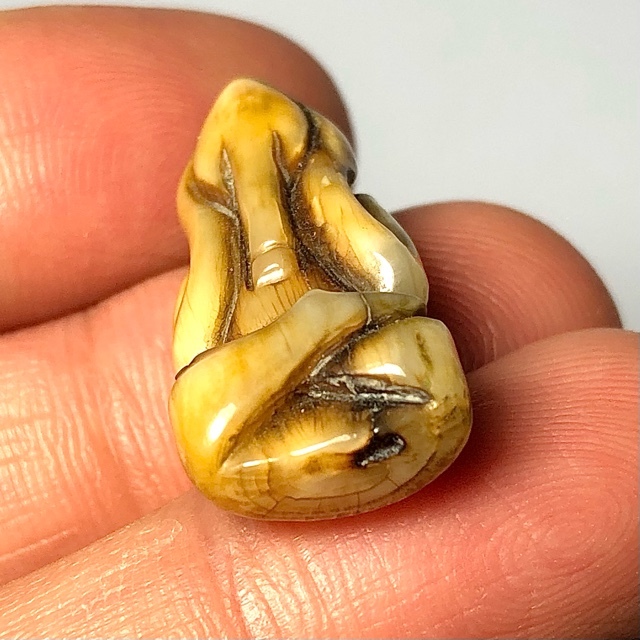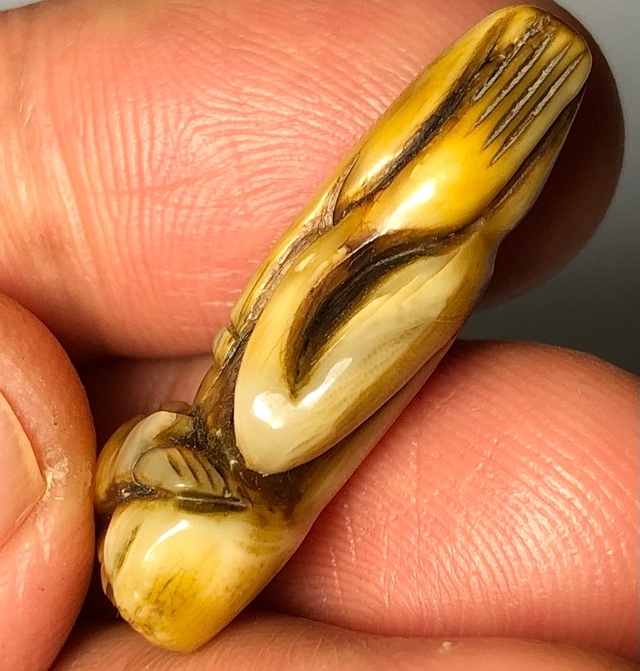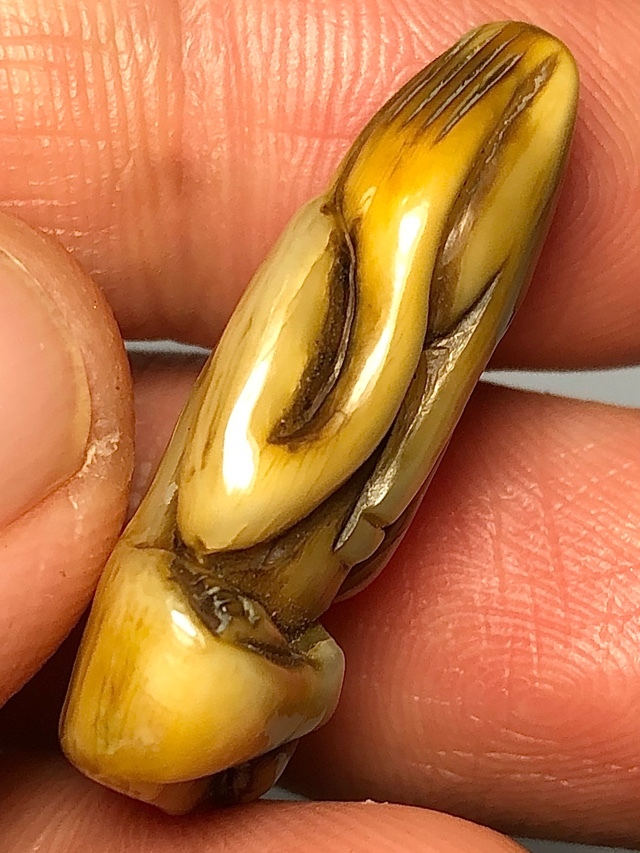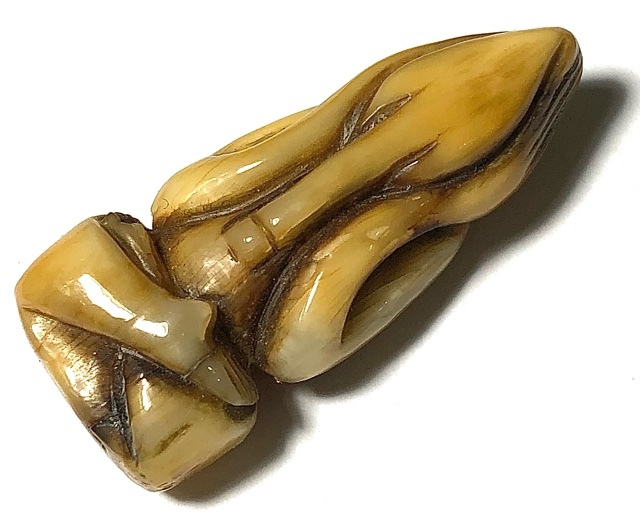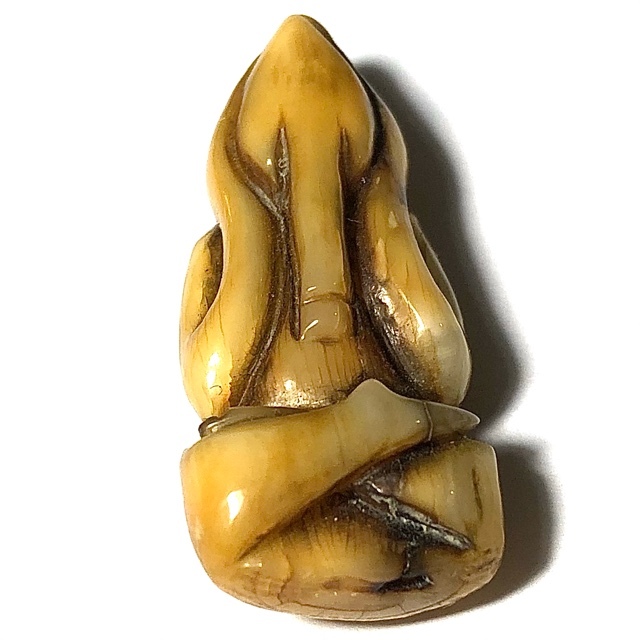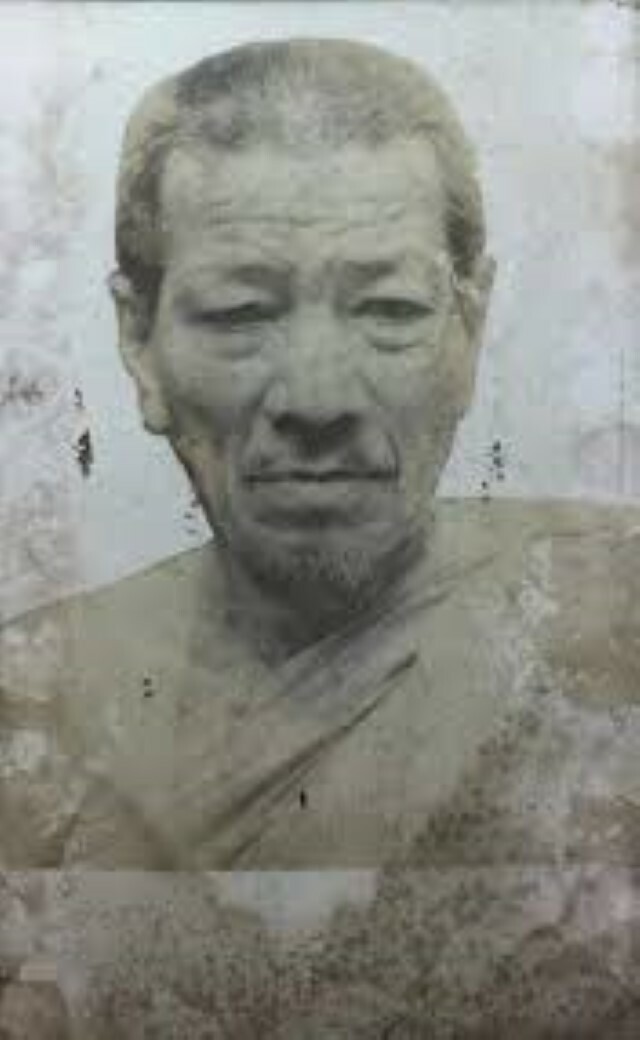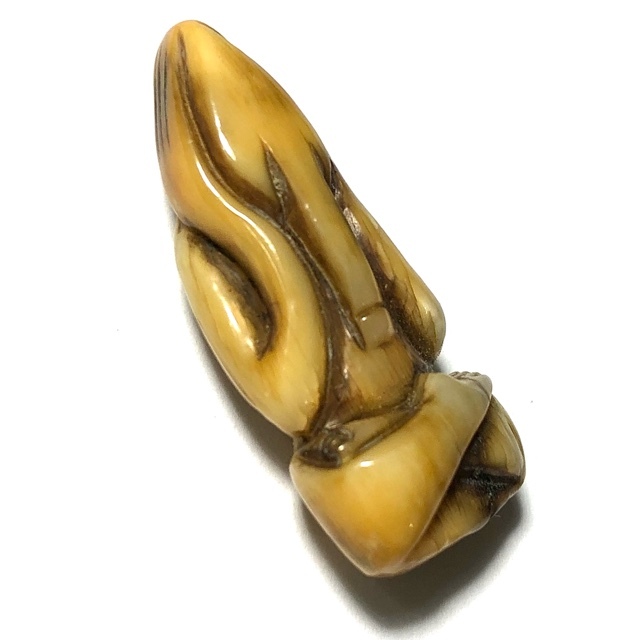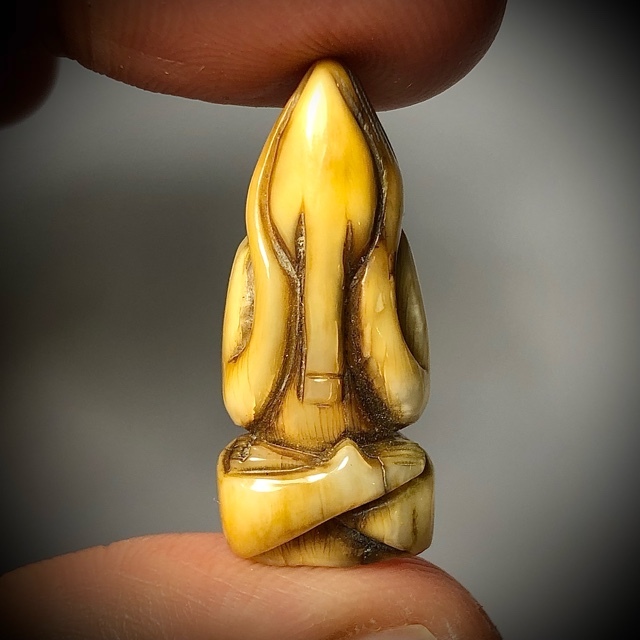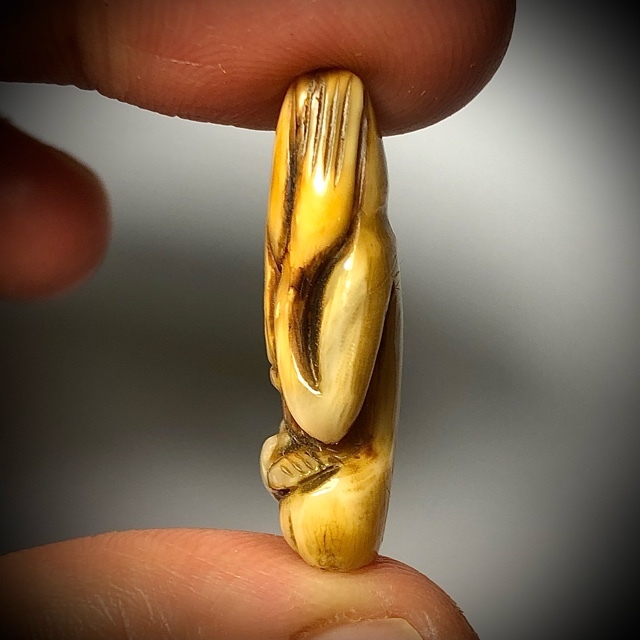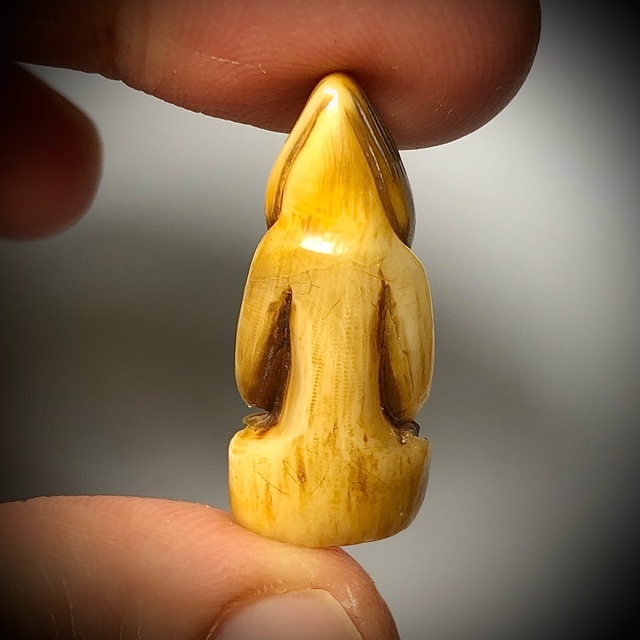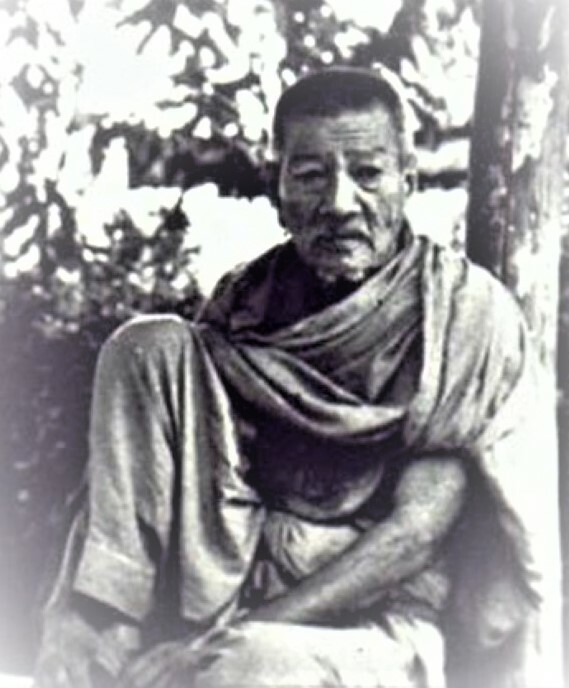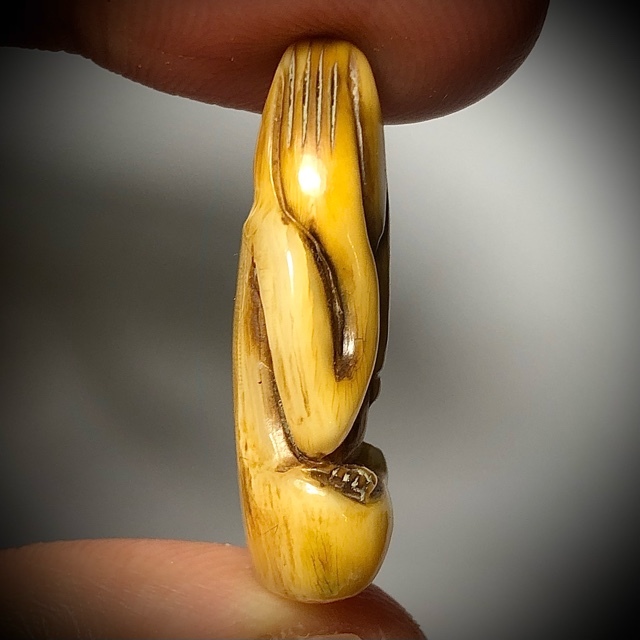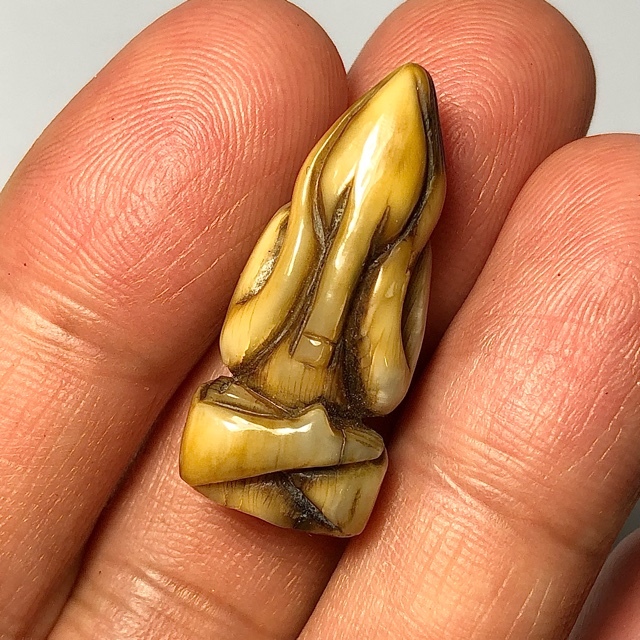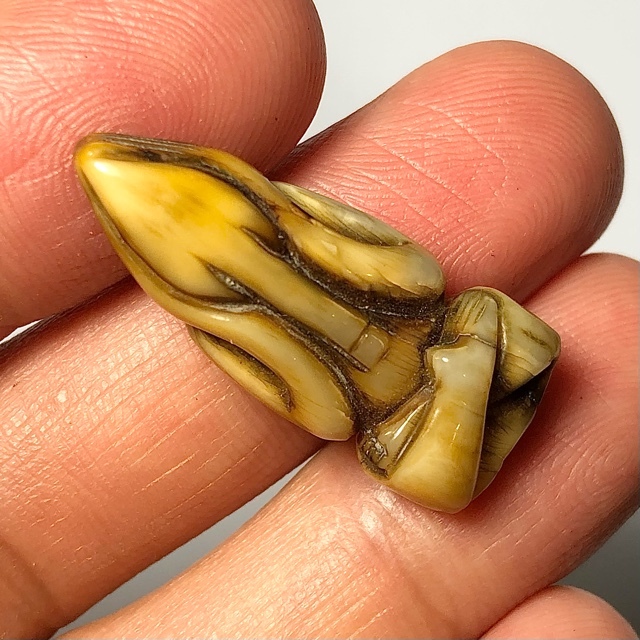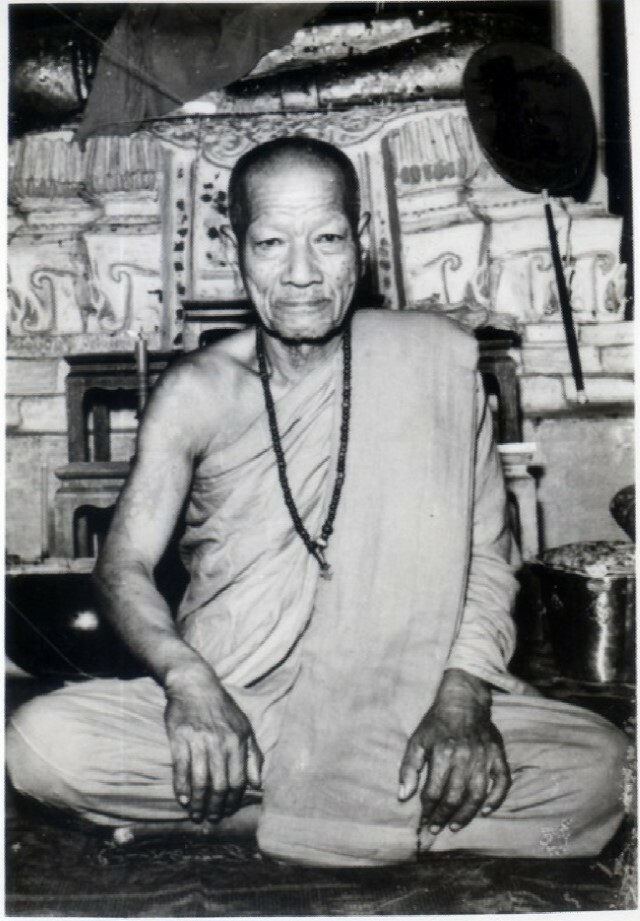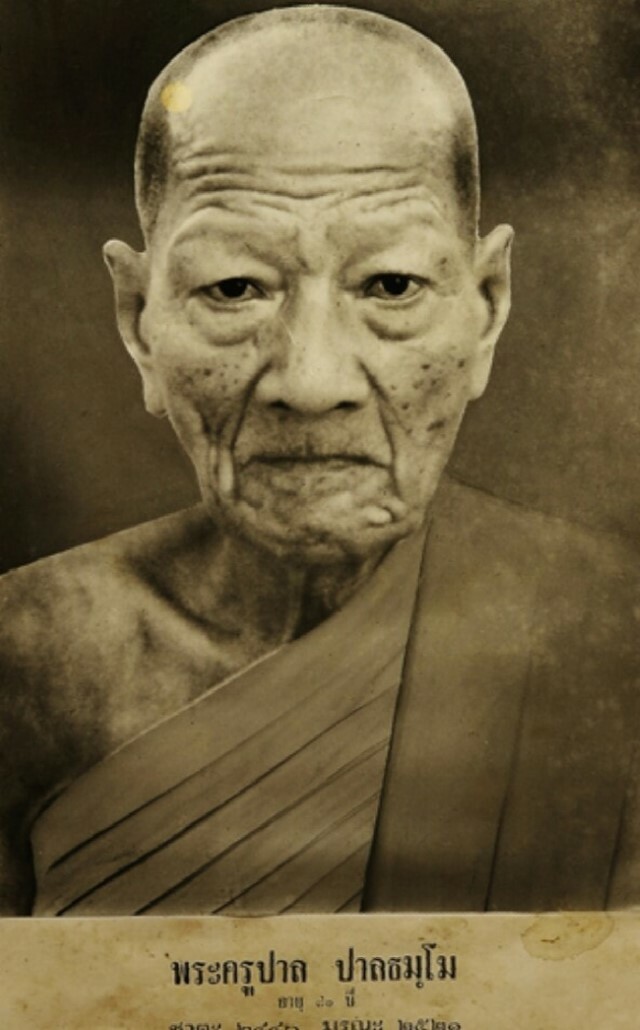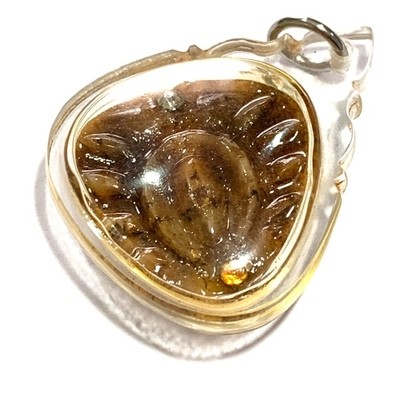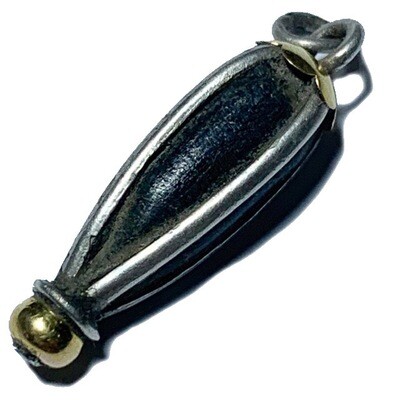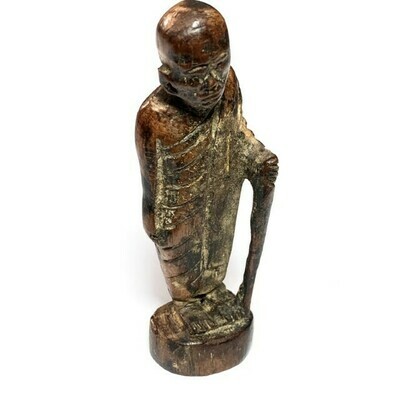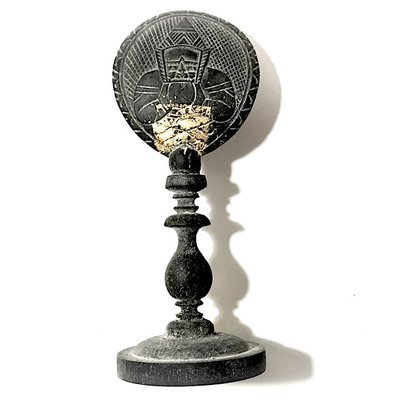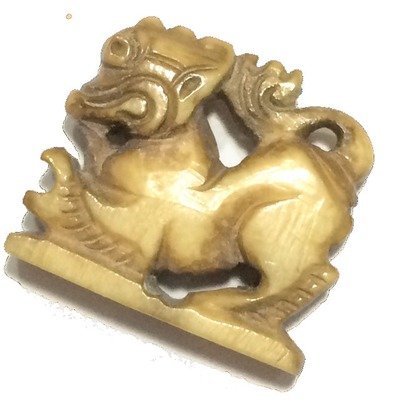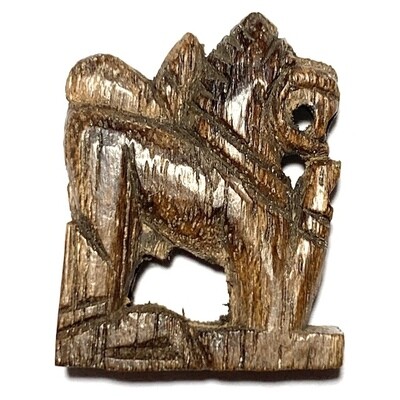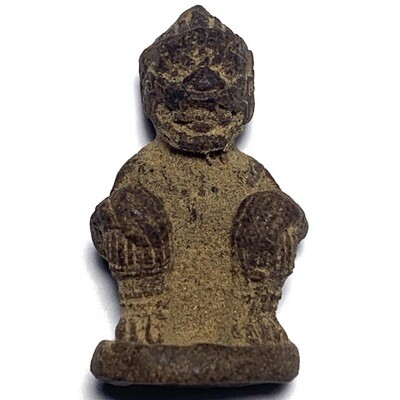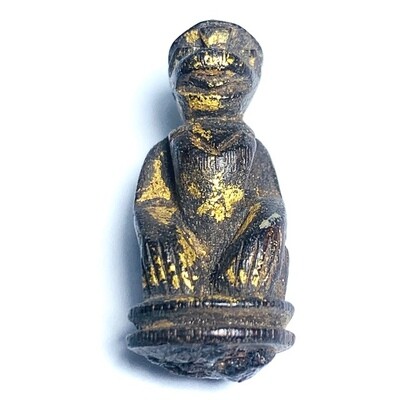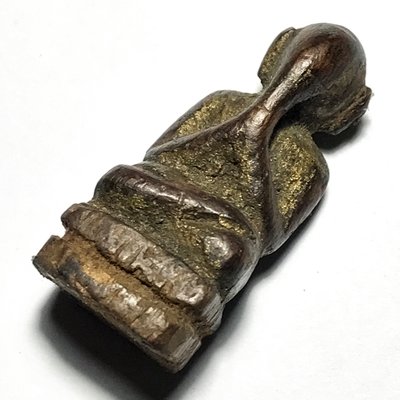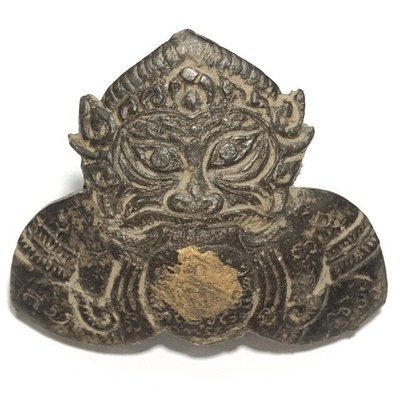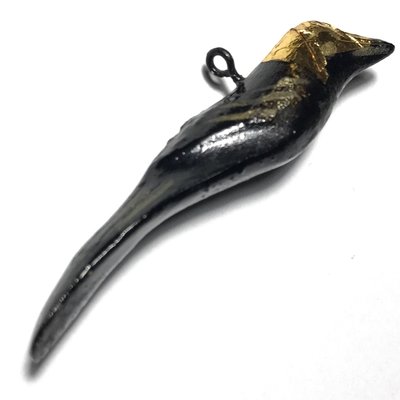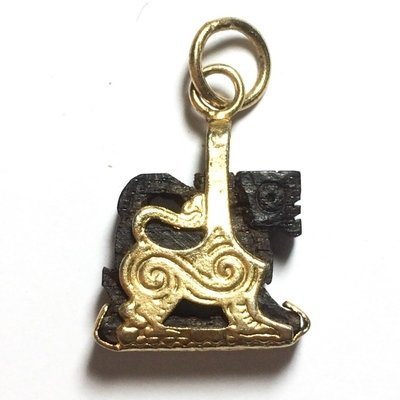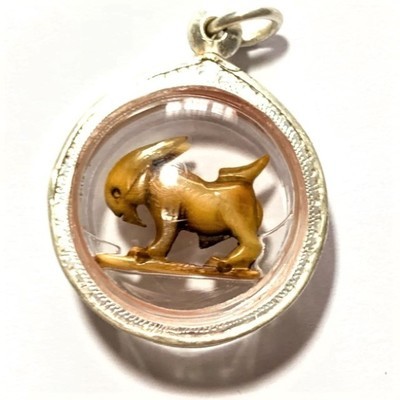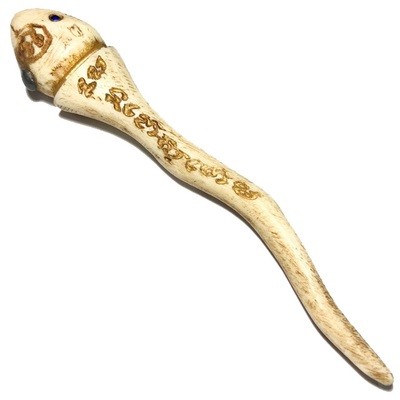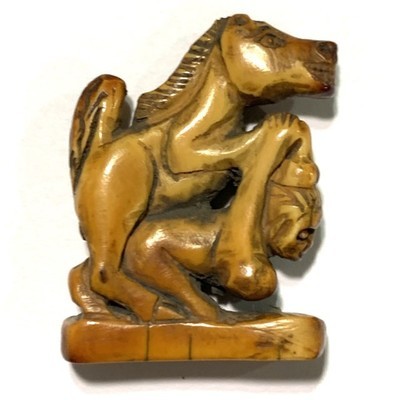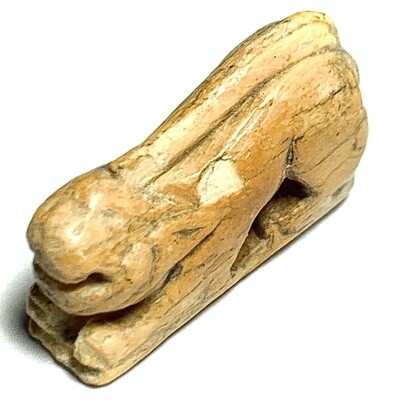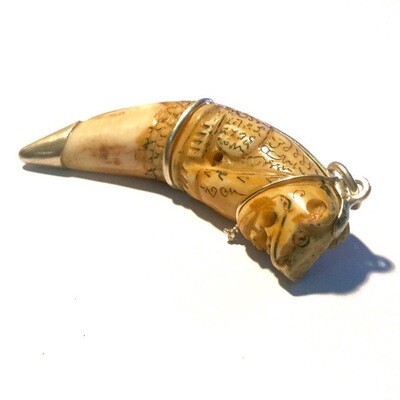A pristinely kept and extremely rare Rian Mangorn Koo Nuea Nava Loha Pim Pised Dtok Sorng Code Ma Wat Pha Nong Lom Run Sao Ha Maha Sethee 5th Lunar Saturday Blessing Ceremony Edition Guru Monk Coin, released in 2543 BE, to raise funds for the Kuti Songk Monks Huts and improve the facilities at the temple of Wat Pha Nong Lom.
This model of Rian Mangorn Koo twin dragons Monk Coin is a very rare Pim Pised (Niyom preferred) and differs from the majority of Rian Mangorn Koo Wat Pha Nong Lom Edition coins in Nava Loha, because of the double code MA stamp. Most coins of the Nava Loha series made for Wat Pha Nong Lom have only a single code Ma Stamp (on the Sangkati chest sash of the robe of Luang Phu), and only the Pim Pised special models received double code stamps. Only very few (unknown number) were distributed with double code stamp, making this not only a sacred, powerful master class amulet, but also a rare collectors piece.
The Rian Mangorn Koo of Luang Phu Hmun is, as are all of his amulets, known for the power of Jaroen Lap Wealth Increasement, and Lucky Fortunes, as well as for their Miraculous Protective Powers. Those born in the year of the dragon love to Bucha this amulet especially, for the obvious reason of the double dragon guardians.
For those with lower budgets, who seek power above collectability and rarity, we recommend to seek the Rian Mangorn Nuea Tong Daeng or Nava Loha single Code Ma, of the same edition, which carries a lower price than this special Nava Loha Pim Pised Gammagarn double code collectors edition model.
Pra Pikanes Pid Tawarn Khao Or Nga Gae Carved Ivory Ganesha Amulet Pra Ajarn Parn, Iad, Jek & Other Khao Or Masters
A most beautiful and masterfully well carved ivory Pra Pikanes (Ganesha) Khao Or Southern Sorcery Tradition hand carved Master-Class amulet, and fine piece of Miniature Thai Buddhist Arts. Empowered by the from the Great Olden Days Khao Or Sorcery Masters, such as Ajarn Iad, Ajarn Jek (2425 - 2491), and Pra Ajarn Parn, Great Sorcerer Monks of Historical Fame and Legend.
This exhibit has Sacred Inscriptions visible on the back, viewed under light, and is a most elegantly and streamlined fashioned ivory Pra Pikanes Elephant God Image. Thhe image is designed with 'Hua Jaruad' (Rocket Head). and the typically slender and flowing lines of design features expected in many of the carved amulets of the Khao Or Tradition. The Ivory reveals its truly ancient origins with its beautiful ochre patina.
Luang Por Jek and Luang Por Iad, and Luang Por Luang Por Parn Bpalatammo, after the Tutelage of Ajarn Tong Tao (Wat Khao Or), were the first and foremost Looksit of Wat Khao Or Sacred Cave Temple, the famous originating temple of the Dtamnak Kunjae Saiyawaet Dtak Sila Khao Or Southern school of Sorcery and Buddha Magic. The Sacred Ivory and Metallurgical Nga Gae Amulets is a Wicha of Serm Duang, Serm Yos, Maha Lap Lucky Fortunes, Kong Grapan Chadtri, and Klaew Klaad Evasive Protection, is effective as a success and promotion, professional luck bringer, and protective spell, against all forms of black magic, sorcery, evil eye, demons and physical dangers, which derive from weapons of war, sharp and blunt instruments.
Free Express shipping is included by either DH, /Fed-Ex or EMS, depending on Availability. Pra Pid Ta amulets have been produced as objects of reverence and protection since very ancient times in Thailand. The artisans of that time created various styles and interpretations, using the various periodic influences of Buddhist art and sculpture available at the time. Various Deity forms were used to make the Pra Pikanes Posture, some with two, four, or multiple arms, seated, standing, slim, smooth and pointed, or plump and highly detailed.
Ganesha has many different Emanations and Postures, but the most Common Traditional Posture of Ganesha, is four armed with Whip Goad, Ritual Axe, an Om in the palm of raised hand, and Fruits as consumable offerings. This Posture and combination induces not only the removal of obstacles and success, but also wealth and plentiful treasures and possessions and well being. The hand wielding an axe, is a symbol of the retrenchment of all desires, bearers of pain and suffering. With this axe Ganesha can both strike and repel obstacles. The goad restrains all inner and outer enemies.
Ganesha, has varius forms, 2, 4, and multiple four arms, which symbolize his status as the universal ruler and, in the case of the four armed emanation, establishes his power over the four categories of beings – those who can live only in water, those who can live in water and on earth, those who can live only on earth and those who can fly in air. It was God Ganesha who instituted the four castes and the four Vedas. One hymn in Sri Bhagavat Tattva, says: ‘In heaven, this child will establish the predominance over gods, on earth over men, in the nether world over anti-gods and serpents.
He causes the four ruling forces of the elements to move, for which he has four arms. You can use the Chants to Ganesha (Pikanes) to epower the potion before use, and to beseech blessings, to attract, and improve your profession, charm, wealth, status, and remove any obstacle that may be preventing you from succeeding in your goals, be they amorous, financial, professional or social goals. Ganesha helps you in all these areas of life.
The Pra Pikanes is carved in the same Nirodha posture of the Pra Pid Tawarn (Buddha with closed eyes/ears/orifices), and is considered not only to be an amulet of auspicious success from Ganesha, but through the Wicha Maha Ud and Nirodha Karma, is also an amulet with ‘Maha Ud’ and ‘Kong Grapan’ power (invincibility and gunstopping power), but is also made as a wealth bringer, in which case, the amulet will be called ‘Pra Pikanes Pid Twarn Maha Ud Maha Lap’. In order to inflect a greater resonance for wealth attraction and auspicious blessings, and Protective Power.
LP Parn, Ajarn Jek (Kroo Ba Ajarn of Khun Pan Rachadej), and Ajarn Iad, were Great and Immensely revered Monk of the Khao Or tradition, with LP Parn initiated directly through the Great Pra Ajarn Tong Tao, initiator of Wat Khao Or, one of the Most Highly favored Ancient Sorceror-Monks of the Southern Tradition in Olden Days.
When mentioning the names of the greatest Khao Or Masters in remembered history, one cannot avoid the name of Luang Por Parn Bpalatammo, along with the other Great Names of Pra Ajarn Tong Tao, Pra Ajarn Kong, Ajarn Jek, Ajarn Iad Bpatumasaro, Pra Ajarn Nam Puttasaro, and the Great Lay Masters; the Police Sergeant Khun Pantagij Rachadech (famous as Master Adept maker of the Jatukam Ramathep amulets, and for catching the greatest Highwaymen and Gangsters in Siam), Ajarn Chum Chai Kiree and Ajarn Plien.
Below; Ajarn Parn Bpālatammo
Luang Por Parn was a Looksit Aek (primary apprentice in Magic), after Ajarn Iad, to the founder of the tradition at Wat Khao Or, the Great Pra Ajarn Tong Tao himself. Pra Ajarn Parn then became his most intimate and entrusted student, and continued the job of Abbot to lead the temple and the tradition onwards after the passing of Pra Ajarn Tong Tao. Ajarn Iad was a secondary apprentice, and also fully versed in the Wicha of Wat Khao Or, and Wat Don Sala. Ajarn Jek has always held his own inimitable reputation for his powerful magic within the Khao Or Lineage, but deemed Ajarn Tong Tao's decision to appoint Luang Por Parn.
Below; Ajarn Iad (Wat Don Sala)
The reason he became Abbot instead of Ajarn Iad, who was the Prime first apprentice, was that that Pra Ajarn Tong Tao had already previously trained and prepared Pra Ajarn Iad for the task of continuing the Dtamnak Dtak Sila Khao Or, but due to the needs of the Buddhist Sangha, Ajarn Iad was called to take over the position of Abbot of the nearby temple of Wat Don Sala, along with his Looksit Pra Ajarn Sri Ngern, who later became the succeeding Abbot of Wat Don Sala.. The devotees of Wat Don Sala came to beseech Ajarn Tong Tao for one of his greatest monks, as they knew that Wat Don Sala and Wat Khao Or had been closely connected with the Wicha Khao Or, since many ages. The devotees were insistent, as Wat Khao Or and the Master Monks of this Samnak, were highly famed for being the most powerful Sorceror-Monks of all, with the most ancient and powerful Sorcery Spells.
Pra Ajarn Tong Tao Hence allowed the devotees of Wat Don Sala to invite Pra Ajarn Iad to take control of Wat Don Sala, and placed his second apprentice in his stead, as the next Looksit Aek, to be trained for full mastery of the Wicha Khao Or, and prepared Ajarn Parn for eventually taking over the temple of Wat Khao Or after his passing. Pra Ajarn Parn was then instructed, as Ajarn Iad before him, in every single spell and ritual practice of the Khao Or Magical Tradition, until he had completed the full Dtamra, and mastered every spell. The Khao Or Tradition of Sorcery has long been considered to be the most powerful in all of Siam, with roots tracing back to well over 1000 years, containing magical spells of the ancient Ruesi Sages and Sorcerers of those times, the magic is of course untouched by modernisation and preserved with its complete original Dtamra.
Wat Khao Or and its Magical Sorcery style derives from the fact that the sacred place of the Khao Or Cave was a place of practice of the ancient Ruesi Sages and Brahmans in the Pre Buddhist Era, and the many magical practices and rituals of that time were written and passed on through the lineage sincde then. This makes the Wicha Khao Or one of the most untarnished and purest of lineages from those days to this time, and is what makes the Khao Or Southern Magic such a worldwide popular phenomenon, with hundreds of thousands of devotees of this magical lineage.
Most Devotees of the Tradition revere all the Masters of the lieage, with ony a few collectors and devotees focusing on one particular master. For us hence, Luang Por Parn and his amulets, and all the other Khao Or Masters mentioned in this document are awarded the same level of faith and respect, and considered equally powerful, regardless of the 'who came first, and who came after' thing, which many people follow, but in fact, it is erroneous, to think that the preceding master is always more powerful than the latter succeeding master.
If we look for example, at the amulets of a Monk made at age 90, who taught another monk half his age, but who also later, also at age 90, after the same years of practice, releases his amulets, we can deduce, that all the Khao Or ancient masters spent the same time, and diligent practice, to master the Wicha, merely lived in different generations. This does not affect ability, mastery, diligence, purity or power in one's practices. Such assumptions should hence be disposed of if one is to be a true student and devotee of the great Sorceror Monks, the Ascended Master Monks, and their Deeds and Amulets, Wisdom and Magical Prowess.
The Wicha Khao Or is perhaps the most complicated of all Wicha (typical Brahman attention to ritual detail and rules), where some spells are fitting for Monks, others better for Lay Masters or Ruesi. Some spells or amulets cannot be touched by ladies, some spells cannot be made by men, only women. Some spells cannot be made by Lay Masters and only by Monks, some spells can only be made by Lersi, or Lay Masters. But he who becomes the head of the temple, must at least know every single Wicha, including the ones they are not allowed to perform themself, depending on if they are a monk, a Lay Master, or a male or female Karavasa devotee.
Below; Sacred Ceremony within the Cave at Wat Khao Or.
This is so that they can teach all the Wicha to each type of student who comes to learn the Wicha.
There is also a strict regulation of protocols for choosing which Master is to become the succession inheritor of the Wicha as the Grand Adept of each generation. Every student who attends the Khao or school of Sorcery must choose whhich Wicha is fitting for them to learn and practice, according to their status of Lay Master, Ruesi, Monk or Karavasa.
1. The person has to possess an auspicious horoscope according to the Prohmachadt (Brahma Jati) Grimoire of Astrological Vedic Knowledge.
2. The person has to be a moral and well behaved, kind and have ggreat equanimity.
3. The person has to have powerful meditative abilities and great spiritual wisdom.
It is of great importance according to the ancient Vedic roots of the Grimoires of Khao or, that the head of the Lineage generation should have a goog Karmic Horoscope, as it has been seen in history that many lineages, be they magical, or even those of the pharoaahs and ancient rulers, we have seen good and bad generations of leaders. So choosing a master whose Karma is auspicious is immensely important to ensure the continued purity of the Tradition, and evade that any generation may have an unfitting Master. The good behavior and morality of the chosen successor, must also be good for reasons, being that this will avoid that there would ever be any events occurring that are inauspicious. He should have great self renunciation, great compassion, and like solitude above the company of others. The succession Master Adept of each generation should be highly devoted to helping others, and selfless, for this is the intention of the Samnak Dtak Sila Khao Or, to be of service to the people and the nation, with a Master of Great Spiritual Wisdom and Compassion, and Immense Miraculous and Magical Powers. We would like to add however, that one should observe that all Miracles are obviously Magical, but not all Magical Spells are Miracles. Miracles are Spiritual in Nature, whereas magic in itself is a form of Wicha (Sacred Art/Science) to which non Miraculous aspects belong, and indeed forgotten sciences, such as alchemical Metallurgy, Ayurvedic Medicine, Herbal and Pranic healing, Crystal Gazing, and the like.
The succession Master of Wat Khao Or must also have great Wisdom and Self Mastery, and be above all a seeker of solitude, for any Monk who seeks too muc conversation and socializing is likely to bring the downfall of the Purity of the Samnak, for they would get lost in the ways of the world too much, and perhaps even develop greed and ignorance. The Wisdom aspect is important, because the Kroo Ba Ajarn Master must not only be self Adept, rather, also be enabled to speak and teach his students in all the myriad of Wicha to be found within the Dtamra of the Wicha Samnak Dtak Sila Khao Or Magical Heritage. Only a monk with wisdom can do this, and only a monk with wisdom is fitting to be master of the Samnak Khao Or Lineage.
Pra Ajarn Parn was hence the second Looksit of the founder of Wat Khao Or, Pra Ajarn Tong Tao, after his first Looksit was given the duty of attending to Wat Don Sala, and is one of History's most revered Khao or Masters. He is also considered to have been the last of the Great Masters of Wat Khao or, after which only the other Khao Or loineage temples have continued with their unbroken lineage of Grand Master Adepts, such as Wat Ban Suan and Wat Don Sala, which both still have living Masters. However, many great ceremonies with blessings and amulets are still released at Wat Khao or to this day with the Khao Or Masters of the Lineage temples attending to empower, despite the fact that Wat Khao Or itself, no longer has a Permanent Master Adept attending as Abbot. This is the law of Anijja, tne first of the 3 Marks of Existence taught by tyhe Buddha,, that all things are born, have their time, and cease to be, and so it was with the Master Lineage of Wat Tham Khao Or, begun by Pra Ajarn Tong Tao through the hundreds of years of lineage mastery passed on to him through his lifetime, of the thousands of years old southern Thai Magical Sorcery sciences. There is little documentation on Pra Ajarn Pal before his appearance at Wat Khao Or, for he was known to be a very private and solitary monk, who never boasted or told stories about his life to others.
It is said that he was a born resident of Ranode in the Songkhla most southern province, who moved with his family to live near the Khao or Mountain in Pattalung. But others say he was born in Ban Khao Or and lived there since birth. Either way, it is known that he ws at Ban Khao or at least since school age, for evidence of his attendance at school is found. His parents were devout followers of Ajarn Tong Tao, so he was sent to be schooled with the Master, and this is how his presence was first documented. Pra Ajarn Parn was said to have been a fast learner, but also a a helpful and beloved friend of the other temple children, for he would often take the blame for the wrongdoings of others in their stead, and take the punishment for them. Once he reached the age of ten he was ordained as a Samanera Novice Monk by Pra Ajarn Tong Tao himself. He is said to have advanced in Wicha very fast even during his time as a novice monk, and onwards after full ordination as a Bhikkhu, became quickly an Adept Sorceror Monk in his own right. Pra Ajarn Parn was renowned fir his Wicha Niw Paetch Diamond Finger spell, which can allow the holder to point to the right and freeze a person as if they were paralysed, or create a myriad of effects, including causing death.
It is said that the Niw Chee Paetch diaond finger of Pra Ajarn Parn would not burn during his funeral, and was unable to cremate. It is rumored that the finger of Pra Ajarn Parn of Wat Khao Or is kept at the Khao or Lineage temple of Wat Ban Suan in Pattalung. Pra Ajarn parn was always the presider over the major ceremonies of that Era, in all the Khao or lineage temples, be it the famed herbal oil bathing ceremony for healing, or the black sticky rice eating ceremony for Kong Grapan. He was a master of Herbal healing Arts, and Talismanic Charm Making, as well as alchemical metallurgy (Len Bprae Taat). He was also renowned in the Wicha Hwaen Pirod Fire Ring of Magical Power and Protection using the Wicha Pra Pirod.
He made many Magical items which are preserved within the annals of historical documentation, such as the Mai Tao Gayasit with Kaya Siddhi substances witjin it, used for healing or exorcisms, and the Prakam Dee Kwai Forest Berry Rosary. As the modern era began to bring changes to Siam, the government began taking over the duty of building schools, and official state education overtook what was until then the duty of Thai Buddhist Temples (schooling). This decreased the number of students attending temple, which was the cause nof the decline in number of monks at Wat Khao Or when the government opened a school, and the scattering of the tradition, which continued through the remaining Looksit oif the tradition, such as the Lay Master Ajarn Plien and Abbot, Pra Ajarn Sri Ngern of Wat Don Sala, and Luang Por Prohm, of Wat Ban Suan, who is the first Looksit of Pra Ajarn Kong of Wat Ban Suan, who passed his apprenticeship with Pra Ajarn Tong Tao.
The amulets of Pra Ajarn Parn Wat Khao or are both far and few between to find, and are extremely tightly held on to by devotees, who revere and have faith in the true power of his amulets and the Wicha of the Lineage of Pra Ajarn Tong Tao, of Wat Khao Or.
Kata Pra Pikanes
Om Pikanesuan Sitti Bprasittimae Mahaa Laapo
Tudtiyambpi Om Pikanesuan Sitti Bprasittimae Mahaa Laapo
Dtadtiyambi Om Pikanesuan Sitti Bprasittimae Mahaa Laapo
Kata Pra PikanesOm Sri Kanesaya Namaha
Use when putting the amulet on and off each day, and as a short Kata when passing Holy Places with Images of Ganesha, or when during daily activities.
Kata Bucha Pra Pikanes (Thai Brahman) from Thailand Amulets on Vimeo.
Kata Bucha Pra Pikanes (Thai Brahman Pali Adaptation)
Ongaarapintunaathang Ubp-Bpannang Prahm-Mano Ja Into Pikanesadto Mahaa Taewo Ahang Wantaa Mi Sappadtaa Sittigijjang Sittigammang Sittigaariyang Bprasitti Mae
Chant this 3, 5, 9 or 108 Times
